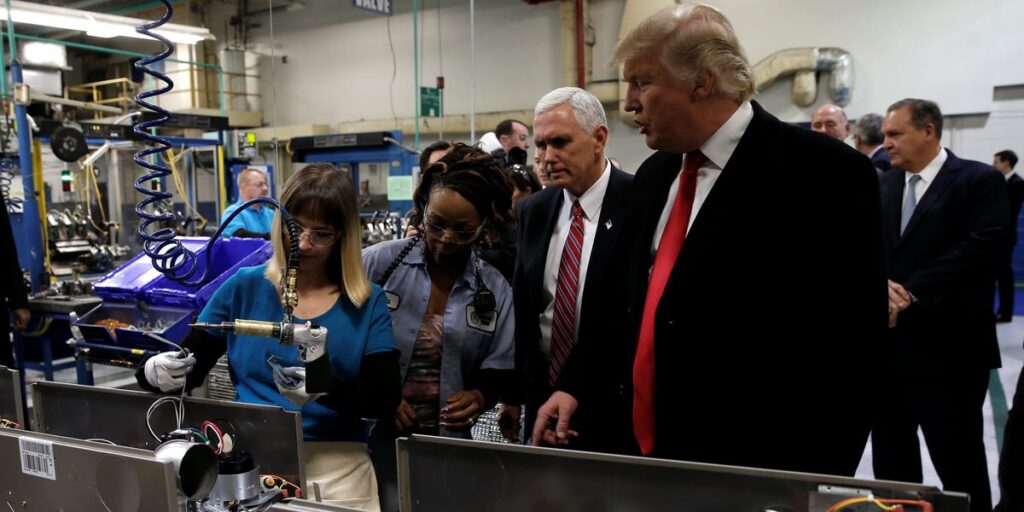The US manufacturing renaissance may need a lot more than tariffs.
President Donald Trump wants to bring back manufacturing, but even if his tariffs manage to stimulate growth in this sector, the industry faces a skills gap, an aging workforce, and negative perceptions — not to mention the potentially mounting cost of hiring domestic labor in comparison to countries like China.
Experts and researchers in trade told Business Insider that the manufacturing sector is struggling to fill the existing open positions.
“Manufacturers have faced a structural challenge for multiple years now,” said Carolyn Lee, president and executive director of the Manufacturing Institute. “The heart of that is most people don’t know what modern manufacturing is all about, that we still are challenged by a perception of what the industry used to be.”
“Our workforce, a lot of them are also retiring, and they are older,” Lee added. “Manufacturers have averaged about 500,000 open jobs every month for several years now.”
The Manufacturing Institute and Deloitte found in an April 2024 report that the manufacturing sector could need as many as 3.8 million net new employees between 2024 and 2033, and that around half of these jobs could remain unfilled if the shortfall in workers with the right skills is not solved.
More than 65% of manufacturing companies consider recruiting and retaining workers as their top business challenge, according to the Manufacturing Institute.
Sameeksha Desai, Associate Professor at Indiana University and director of the Manufacturing Policy Initiative, told BI that job functions and the types of technologies that workers need to know are rapidly changing, and training is struggling to keep up.
“More innovation and more technology uptake are crucial for the industry, but this also means manufacturing companies need to fill needs related to cybersecurity, digital skills, data management, and so on,” said Desai. “These skills can also be workforce concerns.”
Trump made manufacturing a cornerstone of his policy, but experts are skeptical
Bringing back manufacturing jobs has been an integral part of Trump’s campaign promise, which he doubled down on by imposing some of the highest tariffs the country has seen in decades.
Related stories
“Have you ever heard that we’re going to take other countries’ jobs?” he said to attendees during a campaign rally at the Johnny Mercer Theatre in Savannah, Georgia, in September. “We’re going to take their factories — and we had it really rocking four years ago — we’re going to bring thousands and thousands of businesses and trillions of dollars in wealth back to the good ole’ USA.”
“Jobs and factories will come roaring back into our country,” Trump added while announcing sweeping tariffs on April 2. “And ultimately, more production at home will mean stronger competition and lower prices for consumers.”
Howard Lutnick, the secretary of commerce, also proposed having people work in factories for the rest of their lives and then passing the same lifestyle on to their children and grandchildren.
A recent Wells Fargo report says that tariffs are unlikely to bring manufacturing jobs back to America, and Willy C. Shih, a professor of management practice in business administration at Harvard Business School, told BI that some countries like China may indeed have some key advantages.
“Let’s take your typical smartphone that I estimate to have about four hours of labor in it,” said Shih. “In China, you pay between $6 to $8 an hour for that, but in the US, with overhead benefits, healthcare, and other costs, you’ll probably pay $40 an hour.”
“That’s $160 versus $30 for four hours of labor content,” he added.
Desai also says that China’s subsidies for domestic industries are “definitely a big part of the story,” as are well-established industry clusters and regional value chains that help keep costs down.
A solution for the manufacturing shortfall?
Carolyn Lee of the Manufacturing Institute told BI that she thinks a large part of the issue is that people are often being pushed to get a college degree, without thinking about what other well-paid opportunities exist and how to attain those skills.
“Let’s get the learning you need for the job that you aspire to,” said Lee. “I think there are a lot of different opportunities out there, and society shouldn’t just be pushing people to one.”
But it may not be the end of the world even if manufacturing does not return to the US in the desired numbers, according to one expert.
Gordon Hanson, a professor of urban policy at Harvard Kennedy School, told BI that policymakers are “asking the wrong question” by overfocusing on manufacturing.
“The problem we should be trying to solve here is the absence of good jobs, especially for workers without a college degree,” said Hanson. “We’ve lost a lot of middle jobs in middle wage categories over the last 30 years, but most good jobs that non-college workers can get are not in manufacturing.”
“They’re going to be in healthcare, they’re going to be in the construction trades, they’re going to be in the many parts of the information technology industry where you don’t need a four-year degree — there are options,” Hanson added. “What you need is the right sort of technical training you can get in a community college — manufacturing is just one of many options.”


